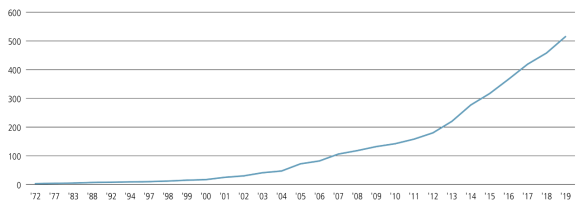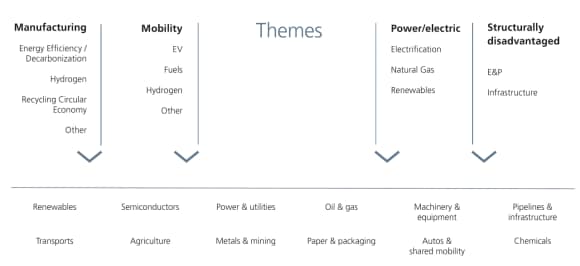Investing for the energy transition
The transition toward the ‘net zero’ goal of carbon neutrality over the coming decades will not only lead to more sustainable economies, it will also likely create significant winners and losers among business sectors.

A consensus is developing among major economies to take action to reduce global reliance on carbon-intensive fuels. A transition to a low-carbon economy is already underway. The Paris Agreement in 2016, which requires countries that have signed on to the agreement to track and ultimately reduce carbon emissions, provided governments and investors guidelines for reducing carbon dependence. COVID-19 and accompanying stimulus packages have accelerated the transition and the development of cleaner, more sustainable energy resources.
Behind the leadership of the world’s largest economies, policy makers are facilitating the adoption of decarbonization technologies and expediting the transition toward electrification, primarily renewables. These decarbonization themes will likely drive compelling investment opportunities for years to come creating a rich opportunity set for long / short investors capable of evaluating business models, as technologies evolve and winners and losers emerge.
Consumers are ready to change
Consumers are ready to change
Consumer concern about climate change and its consequences is growing and has influenced habits, purchase behavior and investment preferences. Particularly with younger consumers, purchasing preferences are evolving to favor more sustainable products and services, and the environment has become a special focus. Millennials, born between 1981 and 1996, are expected to have a huge impact on the transition to lower carbon emissions as they enter their prime earnings years. In a 2015 survey, 73% of Millennials said they were willing to spend more for sustainable goods, a larger percentage than any other age group.1
The trend, however, is apparent across all demographic groups. According to a January 2020 global survey of 9,000 consumers conducted on their views of electric vehicles, 61% of respondents said they expect adoption of electric vehicles to accelerate due to concerns over climate change2. Purchasing preferences are evolving overall to favor more sustainable products and services and as a result, corporate R&D spending is shifting to align with demand.

Government policy and regulation are key drivers of change
Government policy and regulation are key drivers of change
Regulators are playing a central role in incenting businesses to focus on environmental, social and governance issues through policy and spending priorities These policies and regulations (e.g., carbon pricing) will influence private sector investment and technological innovation. The UN’s Principles for Responsible Investing tracks a rapid increase in policy interventions that require or encourage greater attention to sustainability. One policy example is the European Union’s NextGenerationEU, a USD 900 billion initiative to help European economies and businesses transition to a lower carbon future.
The rise of regulation – Cumulative number of sustainable finance policy interventions per year globally
The rise of regulation – Cumulative number of sustainable finance policy interventions per year globally

Global capital markets will pay a critical role
Global capital markets will pay a critical role
Corporate leaders across sectors and financial centers have announced plans to reduce emissions and many have provided a timeframe to achieve these goals. How will they accomplish these objectives? By implementing new strategies and initiatives and investing in technologies to address climate change.
This transition is estimated require spending estimated at as much as USD 95 trillion by 2050, according to the International Renewable Energy Agency (IRENA). The global energy system will require increasing investment in the energy sector by an incremental 16%, or an additional USD 15 trillion by 2050, according to IRENA’s forecast. In total, an estimated USD 110 trillion would have to be invested in the energy system to accomplish a low-carbon transition3.
This process has already has begun and many companies that are solution providers and facilitators have been commanding higher valuations and lower costs of capital. In contrast, structurally disadvantaged industries and companies may be facing shrinking investor bases and more limited access to capital markets. Capital flows, often influenced by policy directives, may serve as a self-reinforcing mechanism that will drive the pace of the transition. We Many believe that the market will reward the providers of new technologies that advance decarbonization and those who execute on well-positioned business models.
Long/short strategy focused on the energy transition economy
Long/short strategy focused on the energy transition economy
We believe this energy transformation will play out across geographies and sectors over many years, representing one of the most compelling and durable investment opportunities over the next decade. Companies affected by or contributing to the energy transition may emerge as winners or losers and we believe that investors who take a long/short approach to equity markets will find compelling investment opportunities.
The O’Connor Environmental Focus strategy, launched in June 2020, is a low net equity long/short strategy that focuses on companies impacted by or contributing to the energy transition. The team takes a top down/bottom up approach to investing and focuses on themes and sub themes that span sectors and geographies.
EFF's strategy incorporates a number of inputs into the fundamental research process including company engagements, financial analysis, and holistic industry analysis to determine which companies will contribute to and which will be impacted by the transition. One fundamental input is EFF's proprietary scoring system, which incorporates both quantitative and qualitative data to determine a holistic, forward looking view of a company's ability to transition.
Traditional scoring relies on self-reported ESG scores that focus on a broad range of social and governance issues in addition to environmental-related measures. EFF takes a different approach and looks at companies whose products, technologies, and business models are consistent with or facilitate low carbon business practices that may be overlooked by traditional scoring as well as those that overstate their positioning and/or commitment to sustainability.
One example is the copper industry, which has not scored high on a relative basis because of the broad brush approach to the mining sector’s carbon footprint, as copper extraction and processing can be energy intensive and environmentally damaging. But copper-intensive products and technologies are necessary to facilitate the global transition to a lower carbon footprint and are needed for both "electrification" and energy efficiency. Using EFF's proprietary scoring methodology, the team believes that copper's positive contributions outweigh the negative environmental impact from extraction and processing.
Another, perhaps counterintuitive example of a transitional focus is the fossil fuel industry. While the oil and gas industry will continue to play a significant role in the global economy for years to come, it is clear that the oil and gas industry is on the wrong side of the decarbonization theme. As the cost of capital for conventional oil and gas projects continues to increase, the industry will likely struggle to maintain production, particularly in the face of rapid decline rates for unconventional reserves. Despite these challenges, EFF believes that fossil fuels will remain important in various “difficult to decarbonize” industries. In addition, advances in decarbonizing technologies, such as “carbon capture and sequestration” (CCS) hold some promise of revitalizing certain industry players. EFF believes that the industry will remain investible for years to come, presenting opportunities on both the long and short side, as the cyclical nature of oil prices creates compelling trading opportunities. Additionally, investment opportunities may continue to emerge as traditional energy companies reposition their businesses into more carbon friendly growth areas.
EFF themes and sub-themes span sectors
EFF themes and sub-themes span sectors
EFF takes a top down/bottom up approach to investing across the Energy Transition Economy
Energy Transition Economy: companies and industries that will be affected by or contribute to the global transition to a more sustainable, lower carbon economy
Market volatility and dispersion will create investment opportunities both long and short as structurally advantaged and disadvantaged industries and companies become apparent over time

Emphasizing the ‘E’ in ESG
Emphasizing the ‘E’ in ESG
Sustainable investing continues to gain ground, with 2020 representing another record year of inflows, according to MSCI, which reports flows of over USD 75 billion into ESG ETFs in 2020, the vast majority of in long-only strategies4. Although investors are interested in all facets of sustainability, the global movement towards reducing carbon emissions should continue to accelerate.
Some companies will face the challenge of maintaining profitability while implementing strategies and initiatives to address climate change. Others will be able to effectively transition. The increased importance of strong balance sheets, access to capital markets, and targeted capital expenditures will help determine the winners and losers. To EFF, this represents an unparalleled investment opportunity which will span themes and sectors that should play out over many years.

